Top 20 Most Popular Danish Foods

Introduction to Danish food culture
Danish food is based on the ingredients caught, collected or grown in the countryside, and they are shaped by the natural, climatic conditions found there.
The Vikings ate fish, chicken, pigs, cows, horses, and goats, all of which they farmed. They also ate grains, cabbage, wild berries, and fruit from trees that could survive the Danish climate. Today, it is the same ingredients that the new Nordic cuisine finds inspiration from.
Since the days of the Vikings, imported food has changed food preferences throughout the country. Spices, rice, pasta, and more exotic fruits and vegetables now come in from all over the world.
There are regional differences too. In Jutland and Funen, people eat more classic Danish food together and plenty of fish, since they are close to the sea. Plaice, herring, salmon, and shellfish are common place on Danes’ dinner tables.
In southern Jutland, they are inspired by German food, being close to the border. In Copenhagen, the capital of Denmark, located on Zealand, the people are more into new Nordic cuisine.
Overall, Danish cuisine is best known for rye bread, smørrebrød (open sandwiches), meatballs, fish dishes, and pastry, while the new Nordic cuisine is becoming increasingly popular.
1. Dansk Hakkebøf med Bløde Løg (Minced Beef with Fried Onions)

This dish dates back to 1888. At that time, meat was chopped by hand on the many Danish cattle farms. Today, Dansk hakkebøf med bløde løg, or minced beef steak with fried onions, is very popular wıth Danes of all generations.
Minced beef is seasoned with salt and pepper, then fried until medium rare or well done. A sauce is made from the pan juices and poured over the steaks, which are topped with thinly sliced caramelized onion. The dish is served with boiled potatoes and pickled beets and gherkins.
Variations on this dish can be found in Danish grill joints. Here, the fried steaks of mince are sandwiched in a toasted burger bun along with pickled beets, ketchup, and remoulade, and, over the top, the hot brown sauce.
2. Karbonader med Stuvede Grønærter (Fried Meatballs with a Vegetable Stew)
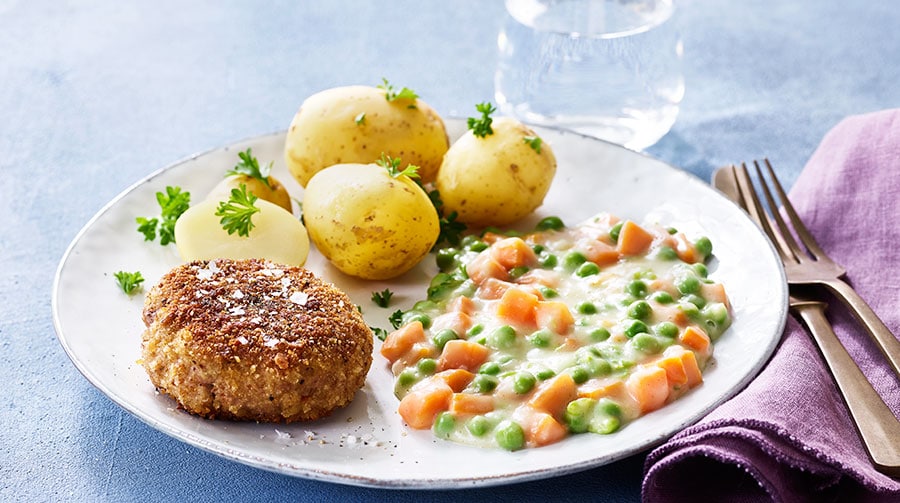
Karbonader, originally inspired by the French crépine, was a great success in the 1950s in Danish kitchens. The dish consists of a flat meatball of minced pork or a mix of pork and veal.
Shaped into a burger, it is then rolled in beaten egg, dipped in a mixture of flour and bread crumbs seasoned with salt and pepper, and fried in butter until golden brown. It is served with either boiled potatoes or potatoes fried in butter, and grønærter, a milk-based gravy.
The gravy is made with butter, flour, the juices from the pan, and green peas and boiled diced carrot.
The dish can also be served with butter sauce, if you feel you haven’t quite got enough butted on your plate. Younger Danes are a bit more savvy these days and find kardonader a tad unhealthy. But still, they love it when grandma makes it as it makes them nostalgic for childhood.
3. Tarteletter med Høns i Asparges (Tartlets with Chicken and Asparagus)
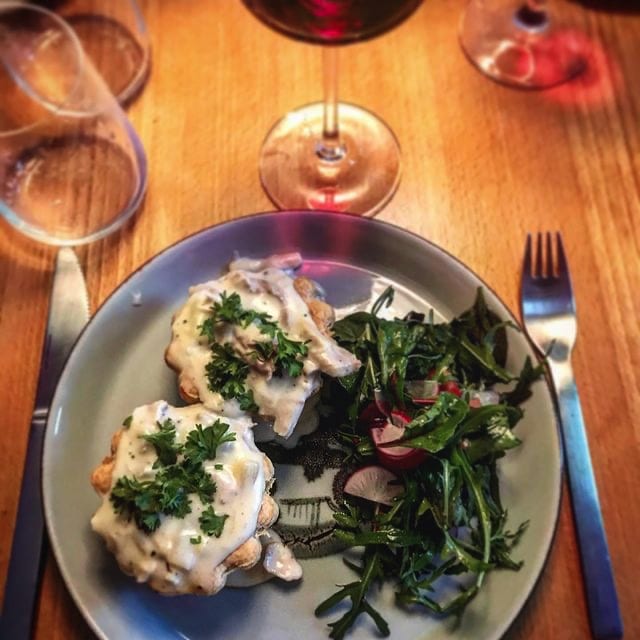
In the late 17th century, the French created tartelettes. They were originally eaten as a dessert filled with jam. Then in the early 1960s, came Danish tartlets with chicken in asparagus. Since then, they have become exceptionally popular. Both young and old love tarteletter, which are often served as a starter or at family celebrations.
The dish is very simple and consists of boiled chicken cut into small pieces, small chunks of white asparagus, and a thick cream-based sauce, flavored with the boullion from the chicken and seasoned with salt and pepper. This luscious filling goes into the crispy lotus-shaped puff pastry shell.
Other fillings are shrimp, meatballs, or chicken with peas and carrots, and all topped with chopped parsley.
4. Flæskesteg med Sprød Svær, Brunede Kartofler og Rødkål (Roast Pork with Crackling, Caramelized Potatoes, and Red Cabbage)
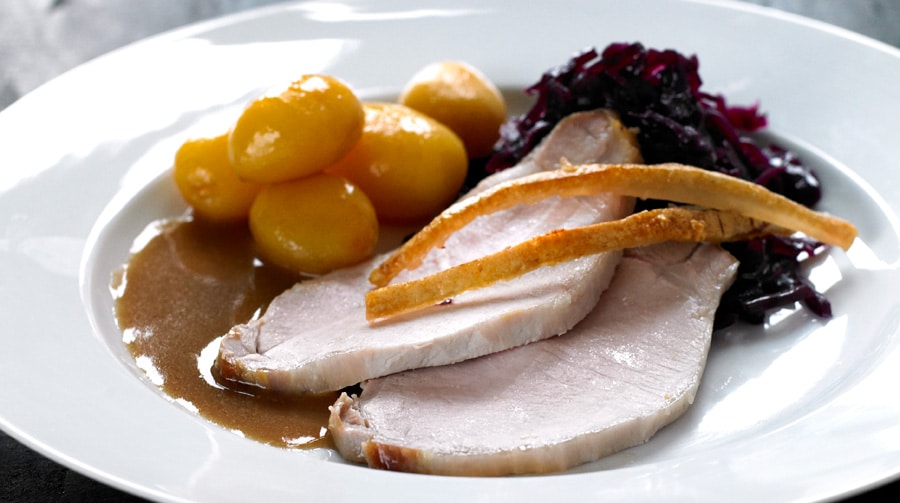
This dish is often eaten on Christmas Eve but also on many other festive occasions and for Sunday dinner. It consists of roast pork seasoned with a lot of salt. The secret of its success is the crackling: the rind is scored in narrow strips so that it puffs up and becomes crispy while it roasts.
The pork roast is served with small boiled potatoes that have been caramelized in a mixture of equal parts butter and sugar, creating golden brown mass in the pan. On the side goes pickled red cabbage, to cut through the sweetness, and, last but not least, a wonderful sauce of thıckened pan juices.
5. Stegt flæsk med persillesovs (Fried Pork Breast with Parsley Sauce)
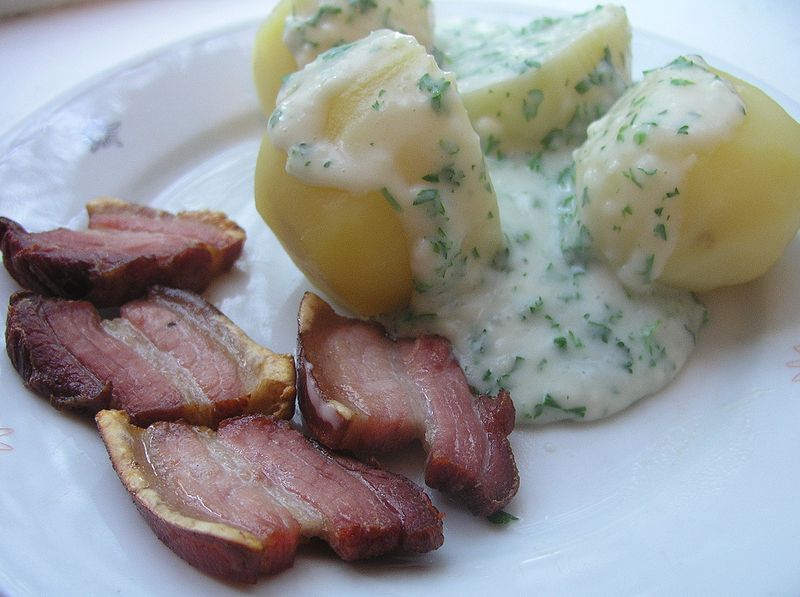
Stegt flæsk med persillesovs has been crowned Denmark’s number one national dish several times, and it goes way back to 1890. The dish consists of 1 cm thick slices of pork breast, the crispiest part and the best texture once seasoned with lots of salt and fried—or put in the oven if you want a healthier alternative.
Accompanying the meat are boiled potatoes and parsley sauce, a milk-based sauce made with the meat juices, a little sugar and lemon juice or zest, and lots of finely chopped parsley. The best sauce is thicken the sauce with flour (avoiding lumps). Many Danes like some pickled beetroot to go with it.
6. Grydestegt Kylling med Skilt Sauce og Mormor Salat (Pot Roasted Chicken with Gravy, Rhubarb Compote, and Granny Salad)
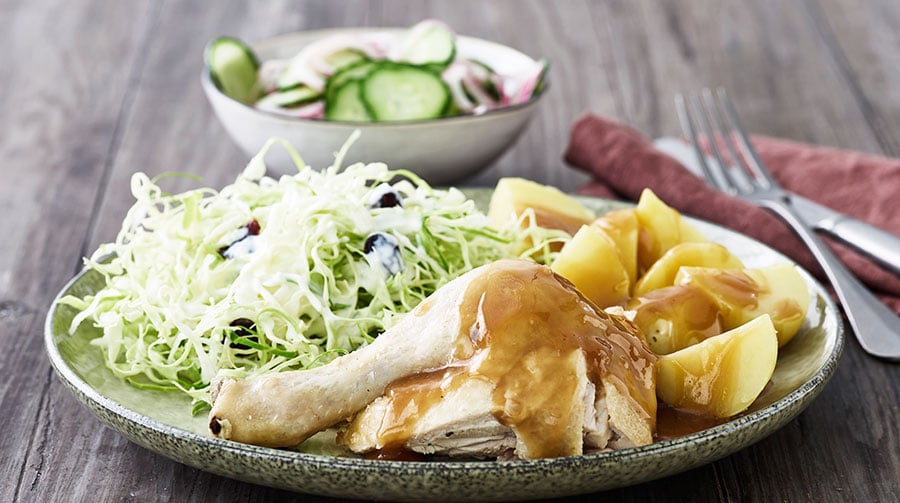
This is a traditional Danish summer dish which contains a lot of the ingredients from the summer kitchen garden, such as fresh potatoes, rhubarb, and hovedsalat, or butter lettuce.
The entire chicken roast is seasoned with salt and pepper and then fried in a large pan with lots of butter until it is completely tender.
The juices from the chicken are made into a gravy with cream. To accompany the dish, small potatoes, cold rhubarb compote, and mormor salat, granny salad, are served. Mormor Salat is a very simple salad consisting only of a roughly sliced lettuce leaf drizzled with a slightly sweet dressing of cream, sugar, salt, and vinegar or lemon juice.
7. Smørrebrød (Rye Bread with Mixed Toppings)
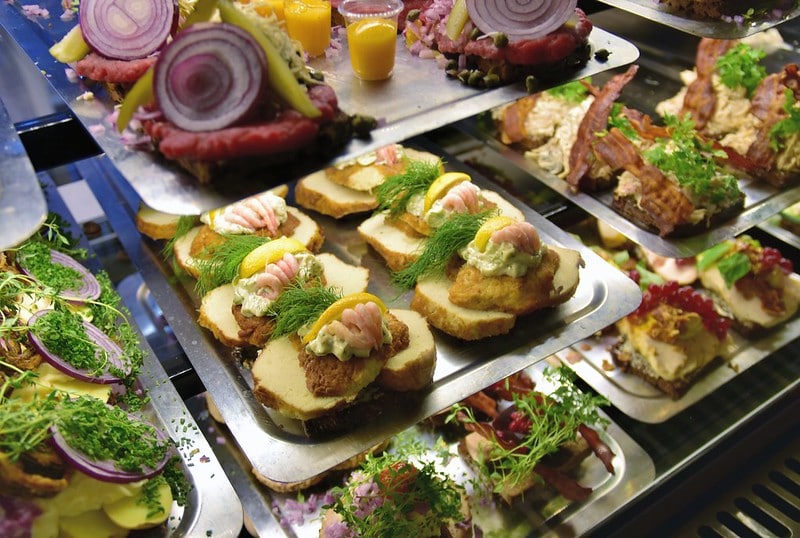
Danish farmers have always eaten rye bread, which contains lots of healthy minerals and vitamins from the coarse flour and often added different types of seeds, such as sunflower seeds, sesame seeds, or flax seeds. On top, they put salami or cheese.
But at the end of the 1800s, a more modern and festive variant of the smørrebrød was invented in Copenhagen, where the Royals and the rich, high society lived. The rye bread was now heavily topped with different types of cold meat or fish.
There are a wide variety of smørrebrød toppings including: fried fish fillet with remoulade; roast beef with remoulade, pickles and horseradish; or sausage roll with an Italian salad of mayonnaise, peas, diced carrot, and sliced asparagus. Other fillings are cooked sliced eggs with boiled shrimps and mayonnaise, pig’s liver pate, called leverpostej, with fried bacon and mushrooms, sliced cold smoked ham topped with mayonnaise, asparagus, tomato, and cucumber or herring with karrysalat, a dressing of mayo, curry powder, chopped boiled eggs, pickles, and capers. The varieties endless.
There are shops in Denmark that only sell smørrebrød, for example the famous Tivoli in Copenhagen. It is an all time favorite for all age groups, and while new Nordic cuisine has modernized the smørrebrød, it is the traditional versions that still come out on top.
8. Frikadeller med Brun Sovs, Kartofler og Surt (Meatballs with Gravy, Potatoes, and Pickled Vegetables)
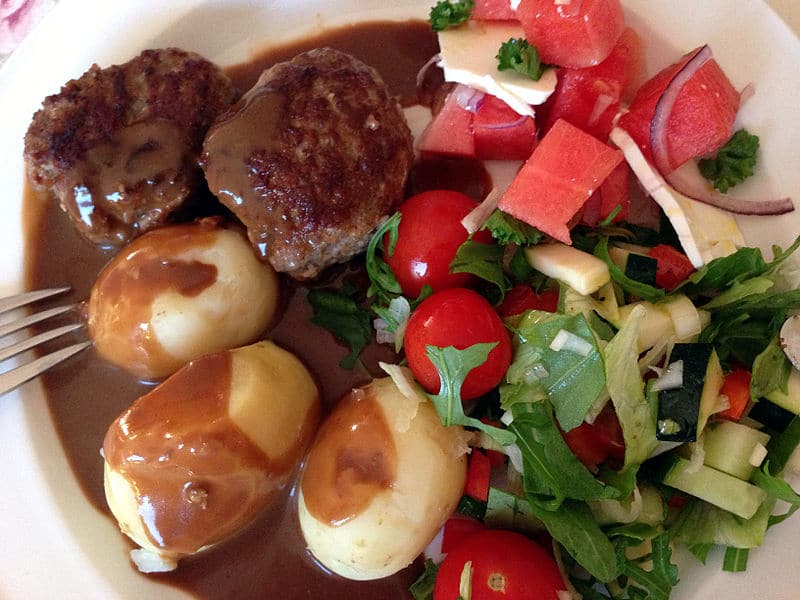
Frikadeller is an everyday classic dish. It is a sort of a Swedish meatball of minced pork or a mix of pork and veal with added eggs, finely chopped onions, milk, and, optionally, bread crumbs. The mix is shaped into golf ball-sized balls and fried in butter or oil until golden and brown. They are served with boiled potatoes, and a gravy made from pan juices is poured over the top.
The meatballs can also be enjoyed with pickled gherkin, pickled cucumber, pickled red cabbage, or a cold potato salad with a dressing of mayo and chopped parsley. They are also popular in a bun with pickled red cabbage and mayo.
9. Brændende Kærlighed Med Kartoffelmos (Burning Love with Mashed Potatoes)

This traditional dinner dish can be dated back to the 18th century, when pork became a staple of Danish cuisine. At this time, bacon was salted and smoked to preserve it. The dish consists of fried diced bacon and diced onion, seasoned simply with salt and pepper. It is served with mashed potatoes and pickled beets.
10. Æbleflæsk (Apple Puré with Smoked Bacon and Onion)
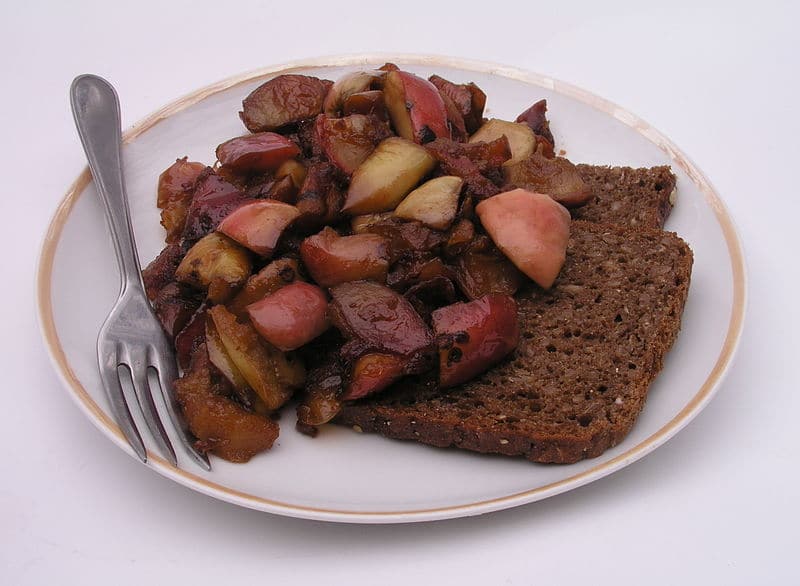
This lunch dish is often eaten for Christmas lunch or at Easter. It was invented in the 16th century on Funen, a Danish island between Jutland and Zealand. The people on Funen had heard that the Romans enjoyed the delıcate combination of apple and pork so developed their own dish, adding a touch of fried onion.
You can make æbleflæsk in the pan in which you fry the diced bacon. Simply put in sliced apples and cook them in the bacon fat until they soften, together with a little chopped onion. Season the dish with sugar, salt, and pepper and eat it with rye bread.
11. Indbagt Svinemørbrad (Pork Tenderloin in Puff Pastry)

This dish was inspired by the British Beef Wellington. It has been very popular since the 1980s for serving to house guests.
Indbagt mørbrad consists of pork tenderloin covered in minced pork with eggs and seasoned with garlic, onion, salt, and pepper. The minced meat is first layered on the rolled out puff pastry, the pre-fried pork tenderloin is placed on the top, and it is all rolled up together just like a Swiss roll.
Once baked, the dish is served with rice or small potatoes drizzled with melted butter, and a mushroom or brown gravy. A crisp green salad also goes well with it.
12. Æbleskiver (Fried Dough with Apple Pieces)

This dish was invented in Southern Jutland (Sønderjylland), close to the German border, in the 17th century. It has changed a bit over time, however, and today it resembles a golf ball.
It is a kind of a sweet vanilla-flavored dough bun filled with grated or small chunks of apple.
Æbleskiver is often eaten around Christmas in its sweeter version with added jam and sugar, together with a cup of hot mulled wine, another Germany influence. But in recent years, it has been adapted to the savory menu, with fish or bacon. Æbleskiver is baked in a specially made pan that produces the perfectly round balls.
13. Hønsekødssupper Med Kød Og mMelboller (Chicken Soup with Meat and Dumplings)
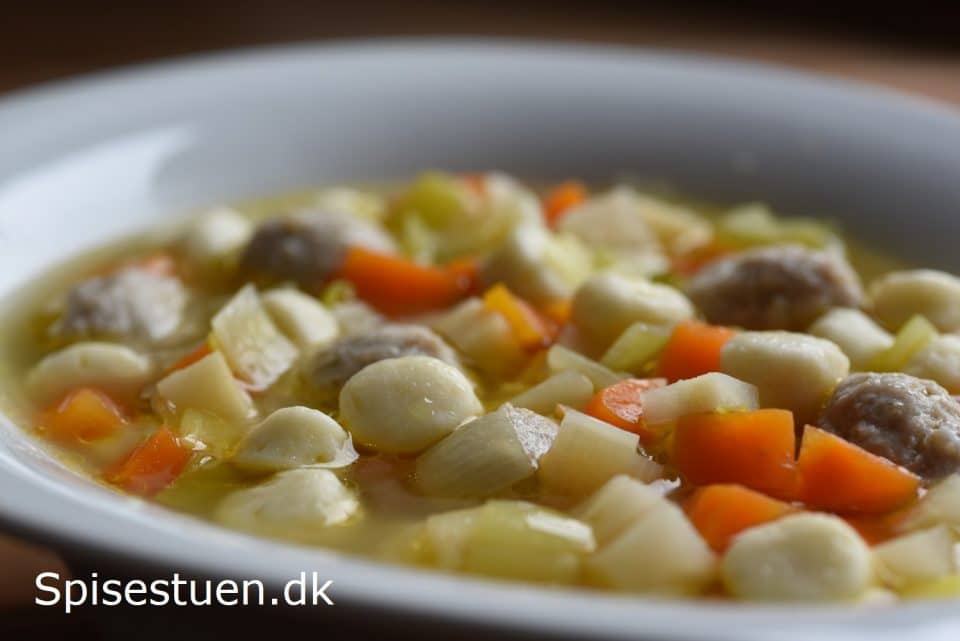
This soup dates back to around the 1800s. It was eaten a lot by the Royals of the Danish court, but found its way down to the homes of lowly Danes. It is a soup of chicken or beef stock and chopped vegetables, such as leeks, celery, and carrot. Submersed in it are very small meatballs, melbolle, or dumplings, made with melted butter, flour, and eggs, which cook in the simmering soup.
The soup is served with sliced bread on the side.
14. Stjerneskud (Shooting Star)

A stjerneskud is sliced French bread filled with fried fish fillets with caviar, shrimps, asparagus, lemon and a thousand island dressing.
The shooting star was invented by Ida Davidsen, a famous Danish chef who owns a smørrebrøds restaurant in the heart of Copenhagen. She was inspired, in 1962, to make the stjerneskud when cosmonaut Yuri Gagarin visited the capital.
When she presented the rocket-shaped dish to Gagarin, Ida Davidsen was surrounded by media and suddenly everyone had heard of stjerneskud. Since then it has remained very popular among Danes and is served in many restaurants, often as a lunch dish.
15. Pariserbøf (Beef Parisienne)
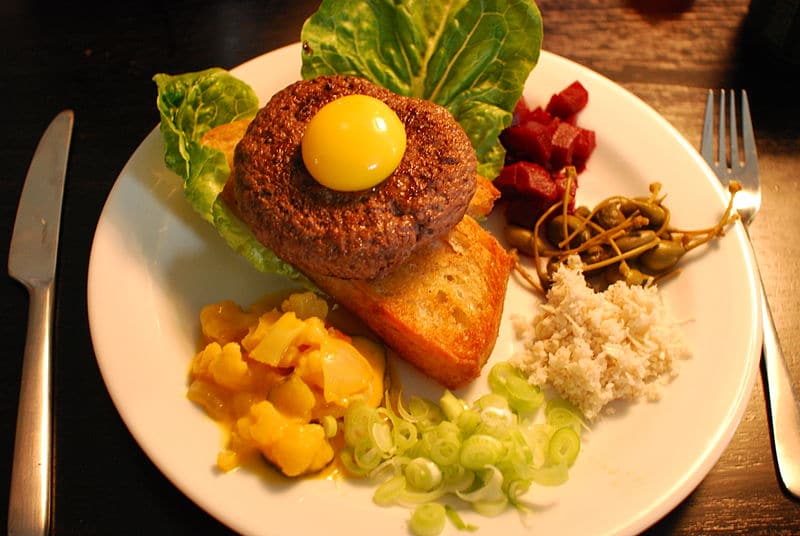
This lunch dish dates from the 1960s. While its name might refer to France, the dish was actually invented in Denmark, taking foreign inspiration with the addition of pickled capers. Beef Parisienne is an open sandwich made with minced beef, seasoned with salt and pepper, and fried in butter.
The medium rare or well done beef is placed on butter-fried French toast and topped with chopped pickled beets, pickled capers, and finely sliced red onions. And, of course, a pasteurized raw egg yolk.
16. Medister med Stuvet Hvidkål og Kanelsukker (Pork Sausages with White Cabbage Stew and Cinnamon Sugar)
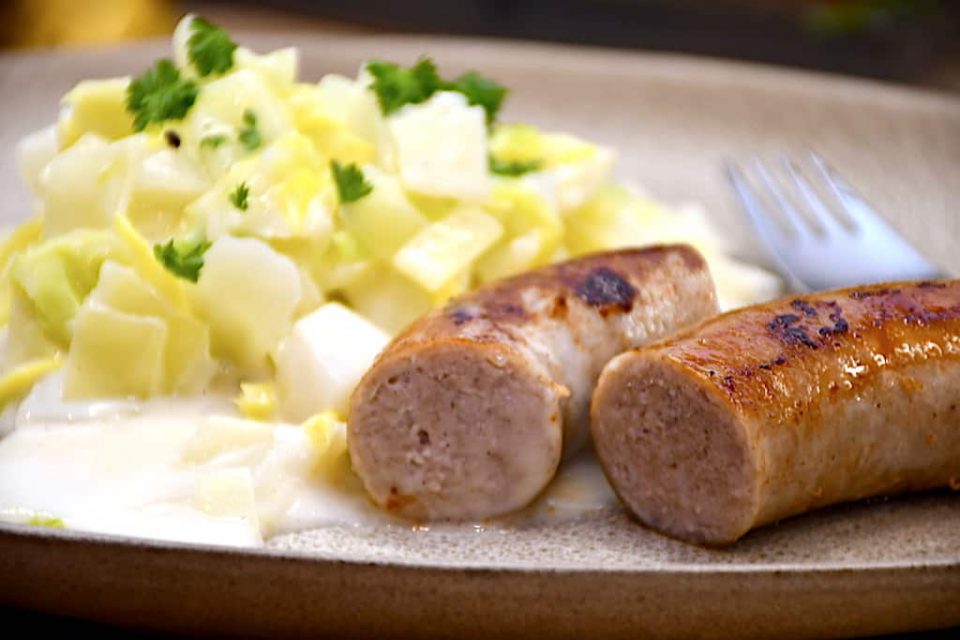
This dinner dish is a classic from the 18th century, when it was eaten mostly by the peasantry, which is why is came to be known as poor man’s food. Danish farmers have always grown and eaten a lot of cabbage. But in recent years, its health benefits have become better known and the vegetable is now a feature of many new Nordic recipes.
Medister sausage is made from finely minced pork and lard seasoned with a special mixture of spices. Its origins are Scandinavian, but it has been made a quintessential Danish dish as it’s eaten with pickled white cabbage, consisting of boiled finely chopped white cabbage in a milk-based sauce, with a little cream for extra creaminess. Older Danes can be seen sprinkling a mixture of sugar and ground cinnamon on top…
17. Grønlangkål med Glaseret Kogt Skinke og Brunede Kartofler (Green Cabbage Stew with Glazed Smoked Ham and Caramelized Potatoes)

Kale has been grown in Denmark since way back, as it does particularly well in the Nordic climate. This green cabbage stew is eaten a lot during Christmas, often at Christmas lunches, during November and December, with work colleagues, friends and family.
Grønlangkål med glaseret kogt skinke og brunede kartofler is a plate of finely chopped kale in a cream-based sauce seasoned with sugar, salt, and pepper. The ham is glazed with mustard and brown sugar and the small potatoes are caramelized. A classic, and an unmissable part of the Christmas celebrations.
18. Grønkålssuppe med Svineskank (Green Kale Soup with Pork Shank)
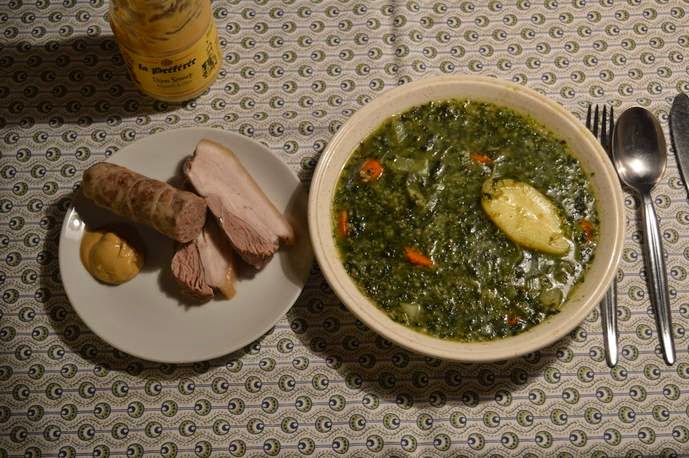
This dish is a classic of Danish home cooking. Many believe the Vikings came home to it after their expeditions.
The main ingredients are boiled finely chopped kale and tender pork shank, cooked for a long time until it is completely tender. The meat stock is added to the cooked kale, together with other vegetables such as sliced carrot, diced potato, and sliced celery. The soup is served with bread and mustard for extra flavor.
19. Venø Steak (Steak from the Danish Island of Venø)
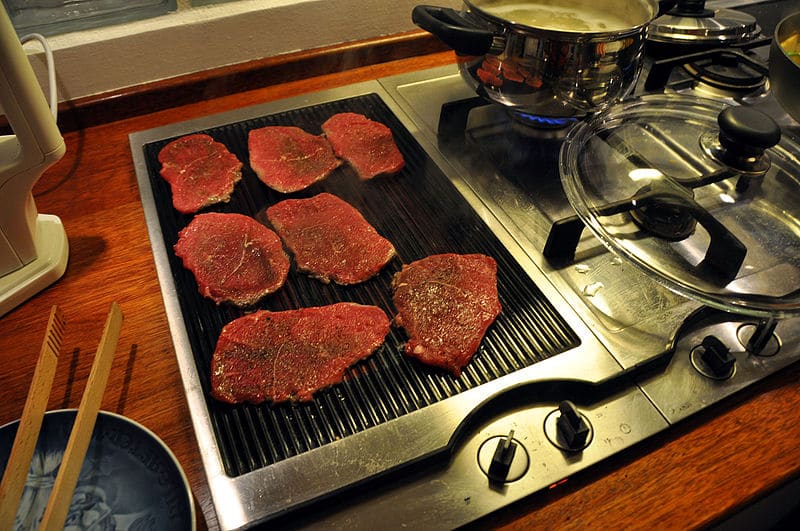
Venø steak was invented almost 40 years ago in the kitchen at Venø Kro, located on the small Danish island of Venø.
It has since become popular across the country. Half centimeter thin slices of beef from the cow’s inner thigh, seasoned with garlic, salt, and pepper, quickly fried, and covered in a paprika sauce with cream, together with mushrooms, onions, and diced bacon. The sauce for the steak can vary. The dish is often served with mashed or boiled potatoes.
20. Boller i Karry (Meatballs in Curry Sauce with Rice)

This dish is loved by many Danes, not least the children, for whom it is a firm favorite. It dates back to 1935 and was inspired by India cuisine. The Danes may go for the spicy taste but not so much the spicy heat; the sweet curry flavored sauce is quite mild.
The dish consists of medium-sized balls of minced pork seasoned with salt, pepper, and finely grated onion. Flour and eggs hold the mince together as they cook in boiling water. Once cooked, they are added to the curry sauce, and the whole dish is served with rice.
Related: Most Popular Danish Desserts
Related: Most Popular Danish Cheeses

Related: Popular Danish Christmas Food

Related: Popular Danish Cookies


